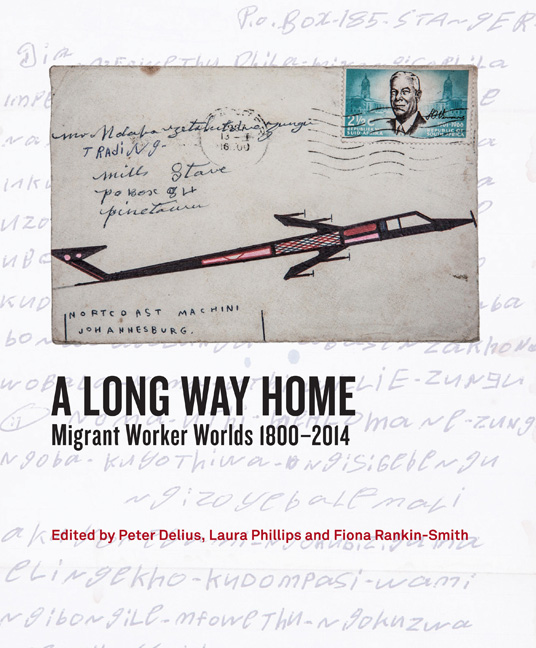Book contents
- Frontmatter
- Contents
- Acknowledgements
- Introduction: Highlighting Migrant Humanity
- Chapter 1 Ngezinyawo - Migrant Journeys
- Chapter 2 Slavery, Indenture and Migrant Labour: Maritime Immigration from Mozambique to the Cape, c.1780–1880
- Chapter 3 Walking 2 000 Kilometres to Work and Back: The Wandering Bassuto by Carl Richter
- Chapter 4 A Century of Migrancy from Mpondoland
- Chapter 5 The Migrant Kings of Zululand
- Chapter 6 The Art of Those Left Behind: Women, Beadwork and Bodies
- Chapter 7 The Illusion of Safety: Migrant Labour and Occupational Disease on South Africa's Gold Mines
- Chapter 8 ‘The Chinese Experiment’: Images from the Expansion of South Africas ‘Labour Empire’
- Chapter 9 ‘Stray Boys’: The Kruger National Park and Migrant Labour
- Chapter 10 Surviving Drought: Migrancy and the Homestead Economy
- Chapter 11 Migrants from Zebediela and Shifting Identities on the Rand, 1930s–1970s
- Chapter 12 Verwoerd's Oxen: Performing Labour Migrancy in Southern Africa
- Chapter 13 ‘Give My Regards to Everyone at Home Including Those I No Longer Remember’: The Journey of Tito Zungu's Envelopes
- Chapter 14 Sophie and the City: Womanhood, Labour and Migrancy
- Chapter 15 Bungityala
- Chapter 16 Migrants: Vanguard of the Worker's Struggles?
- Chapter 17 Debt or Savings? Of Migrants, Mines and Money
- Chapter 18 Post-Apartheid Migrancy and the Life of a Pondo Mineworker
- Notes on Contributors
- List of Figures and Tables
- Index
Chapter 2 - Slavery, Indenture and Migrant Labour: Maritime Immigration from Mozambique to the Cape, c.1780–1880
Published online by Cambridge University Press: 04 July 2018
- Frontmatter
- Contents
- Acknowledgements
- Introduction: Highlighting Migrant Humanity
- Chapter 1 Ngezinyawo - Migrant Journeys
- Chapter 2 Slavery, Indenture and Migrant Labour: Maritime Immigration from Mozambique to the Cape, c.1780–1880
- Chapter 3 Walking 2 000 Kilometres to Work and Back: The Wandering Bassuto by Carl Richter
- Chapter 4 A Century of Migrancy from Mpondoland
- Chapter 5 The Migrant Kings of Zululand
- Chapter 6 The Art of Those Left Behind: Women, Beadwork and Bodies
- Chapter 7 The Illusion of Safety: Migrant Labour and Occupational Disease on South Africa's Gold Mines
- Chapter 8 ‘The Chinese Experiment’: Images from the Expansion of South Africas ‘Labour Empire’
- Chapter 9 ‘Stray Boys’: The Kruger National Park and Migrant Labour
- Chapter 10 Surviving Drought: Migrancy and the Homestead Economy
- Chapter 11 Migrants from Zebediela and Shifting Identities on the Rand, 1930s–1970s
- Chapter 12 Verwoerd's Oxen: Performing Labour Migrancy in Southern Africa
- Chapter 13 ‘Give My Regards to Everyone at Home Including Those I No Longer Remember’: The Journey of Tito Zungu's Envelopes
- Chapter 14 Sophie and the City: Womanhood, Labour and Migrancy
- Chapter 15 Bungityala
- Chapter 16 Migrants: Vanguard of the Worker's Struggles?
- Chapter 17 Debt or Savings? Of Migrants, Mines and Money
- Chapter 18 Post-Apartheid Migrancy and the Life of a Pondo Mineworker
- Notes on Contributors
- List of Figures and Tables
- Index
Summary
Mozambique has been a major site for the export of labour to South Africa for close to 250 years. The development of a vast system of migrant labour to the diamond and gold mines has dominated this story. What is less well known is the history of Mozambique as an exporter of labour to the south-western tip of Africa where the importation of slaves and other forced immigrants transitioned, with little interruption, to the importation of migrant workers. This chapter focuses on the exportation of labour from Mozambique over a century, starting around 1770, and draws attention to the hesitant transition in labour relations at the Cape as they shifted from slavery to indenture and, finally, to contracted labour migration. It outlines the extreme violence needed to establish a labour force and notes that, as in other parts of the world, the end of slavery created the need for imported, foreign labour held under strict indenture. The final part of the chapter examines how the coercive nature of this inheritance came to underlay the system of migrant labour.
The chapter starts by examining the growth of the trade in slaves from Mozambique to the Cape at the end of the eighteenth century. It argues that at this early stage the Portuguese colony began to depend for its revenues on the export of human capital. The sale of the colony's major means of production fatally undermined its ability to attract immigrants and investment, as had Brazil or the Cape Colony, and institutionalised a dependence on the export of labour. Chattel slaves dominated the early years of this trade, but with the implementation of abolition at the Cape in 1808, two new waves of forced immigrants moved from Mozambique to the British colony where they acquired limited rights as freed or ‘apprenticed’ slaves. Like the slaves, they initially came from northern Mozambique, the areas north of Cape Delgado and Madagascar. But as Mozambique opened to trade with Brazil, forced immigrants arrived at the Cape in greater numbers from Quelimane, as well as from Inhambane and Delagoa Bay. During the 1850s, the commerce in slaves across the Atlantic declined sharply and the East African slave trade turned northwards.
- Type
- Chapter
- Information
- A Long Way HomeMigrant Worker Worlds 1800–2014, pp. 36 - 48Publisher: Wits University PressPrint publication year: 2014



